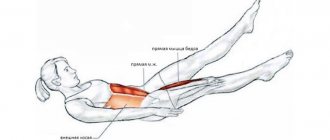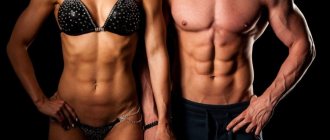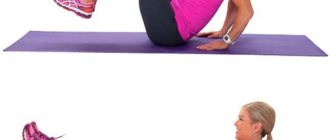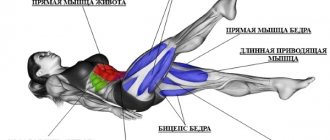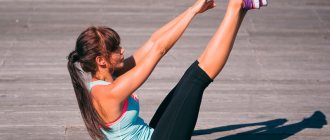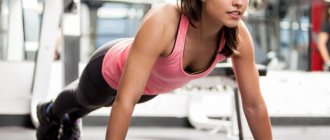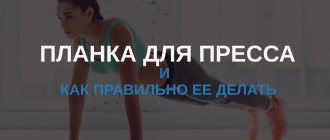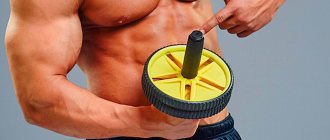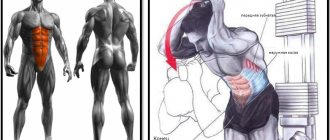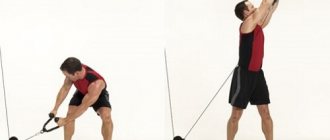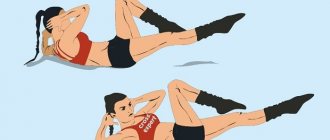The most exciting areas when losing weight are the lower abdomen, thighs and buttocks. The “scissors” exercise will help get rid of annoying excess fat in this area.
- What muscles does it use?
- Benefits and Benefits of Exercise
- Options for “scissors”
- Classic vertical and cross scissors
- Video: how to do the exercise correctly, technique for performing classic “scissors”
- 90 degrees
- 60 degrees
- 30 degrees
- 10 degrees
- Reverse scissors for pumping legs and abs
- Lying on the floor
- Lying on a bench
- High scissors
- Video: technique for performing high leg scissors
- Secrets and subtleties of the exercise
What muscles does it use?
The exercise has a particular effect on the abdominal and thigh muscles. Most work during its execution:
- abdominal muscles responsible for the abs: rectus, oblique and transverse;
- vastus lateralis;
- rectus femoris muscle;
- adductor magnus and longus muscles;
- hamstring biceps.
Exercises to prepare for pregnancy
Physical exercise is aimed at achieving four main goals:
- Prevention of flat feet.
- Strengthening the abdominal muscles.
- Training the muscles and ligaments of the pelvic floor.
- Strengthening the back muscles.
Experts recommend starting with light loads. Walk on the floor barefoot for two minutes, then walk on your toes, on the inside and outside of your feet (one minute, not each exercise). Alternate these types of walking for six minutes. This part of the workout should be completed with normal walking.
Benefits and Benefits of Exercise
Due to the fact that “scissors” affect the abdominal muscles, as well as the superficial and deep muscles of the thigh, the following elements of the body are improved when performing the exercise:
- abs (depending on the goal and the applied load, you can get both a flat tummy and the coveted cubes);
- a waist that becomes more beautiful and thin;
- due to the tension of the transverse muscle, correct posture is formed;
- thighs become more toned;
- Legs become slimmer due to tension in the thigh muscles.
Common execution errors
The most common mistakes that athletes make when performing scissors:
- raise your back from the surface, which can lead to spinal injury;
- bend the knee joints and thereby reduce the load on the abdominal muscles;
- They tear their heads off the floor, which is why they quickly lose strength.
The scissor exercise is a simple way to train your leg and abdominal muscles. It has a number of advantages and has no contraindications. If you do it correctly, you will quickly achieve your goal.
Options for “scissors”
There are several types of “scissors”, alternating and combining which you will make the workout more interesting and effective, since the muscles will not get used to the monotonous load.
Classic vertical and cross scissors
Classic and cross scissors differ in the planes in which the leg swings are performed. With classic “scissors” swings are performed vertically: when the left leg is lowered, the right leg rises, and vice versa. The legs do not touch the floor. When performing the cross scissors exercise, swing the legs from side to side: the right leg goes to the left, the left leg goes to the right.
Video: how to do the exercise correctly, technique for performing classic “scissors”
These types of “scissors,” in turn, are divided into subspecies. Depending on your physical fitness, the exercise is performed at an angle of 90, 60, 30 or 10 degrees.
90 degrees
If you are a beginner, are overweight, or are currently undergoing rehabilitation after an injury, then start with scissors at 90 degrees.
- Starting position - lying on your back, arms extended along the body. To make the exercise a little easier, you can grab the edges of the mat with your hands - this will help press your lower back to the floor.
- Bring one leg up perpendicular to the floor, then switch legs without lowering your feet to the floor.
- We breathe with our stomachs, counting in order from 1 to 10: on the first ten, we inhale slowly and deeply, on the second, we exhale.
We repeat the exercise for 20–30 seconds in 3–5 approaches.
60 degrees
After some time of practicing “scissors” in a 90-degree position, you will no longer feel discomfort in your back when lowering your legs. This means that it’s time to move on and move to a higher level, lowering your legs a third lower - at an angle of 60 degrees.
The procedure for performing the exercise is the same as described above.
- Lie down in the starting position: your arms are on the back of your head or extended along your body, your legs are raised at an angle of 90 degrees;
- Lower your legs 30 degrees lower and perform the exercise, alternating vertical and horizontal swings;
- Watch the rhythm of your breathing!
Perform 3-5 approaches. The goal is to immediately raise your legs 60 degrees, and do not bend them when lowering to the floor.
30 degrees
After some time, you can go even lower - 30 degrees.
- We lie down on our backs. We place our hands under the lower back or buttocks. Legs at an angle of 30 degrees;
- We perform the exercise using an already known algorithm. The lower back should be pressed tightly to the floor, the shoulder and neck muscles should be relaxed.
We perform at least 3 approaches 3 times a week.
10 degrees
The most difficult level is “scissors” at a height of 10 degrees. This level can only be achieved by those who have good physical fitness.
- Take the starting position - lying on your back, hands under your buttocks, legs extended.
- Raise your legs to a height of 10–15 cm.
- Make horizontal or vertical swings without touching the floor surface. Our goal is to gradually increase the frequency of the swings, doing 4 swings per breath.
When performing the “scissors” exercise, you can use additional tools: a gymnastic ball, small dumbbells for the arms and weights for the legs weighing 0.5 kg.
Reverse scissors for pumping legs and abs
You can do vertical and horizontal leg swings while lying on your stomach. In this position, in addition to the abdominal and hip muscles, the gluteal muscles are effectively used.
Lying on the floor
- We take the starting position: lie on your stomach, hands under your chin. You can hold your head straight or rest it on your hands - monitor your sensations and position yourself in the way that is most comfortable for you.
- We make horizontal swings with our legs without touching the floor. Perform 10–20 swings in one approach.
This type of exercise can be complicated if you extend your arms straight in front of you and swing both arms and legs at the same time.
Lying on a bench
Using a bench or exercise machine, in the reverse “scissors” position, you can perform not only horizontal, but also vertical swings.
- Position yourself on a bench so that your body is lying on it and your legs are in the air. With your hands, firmly grasp the edge of the bench.
- Perform 10 vertical and horizontal swings, remembering to monitor your breathing and balance.
High scissors
Those who are familiar with a fitness technique such as Pilates know a special type of “scissors”, in which the lower part of the body is suspended.
- Lying on your back, extend your arms along your body, place them palms down. Straighten your legs and raise them to an angle of 60 degrees or higher.
- Slowly lift your pelvis off the floor (your feet should be above your head), supporting yourself under your lower back.
- Take a breath. Lower one leg, the other should remain motionless.
- Change the position of your legs as you exhale.
- Repeat the exercise 10 times for each leg.
- When finished, bring your legs together above your head and slowly lower your lower body to the floor.
Perform this exercise only if you are in good physical condition.
Video: technique for performing high leg scissors
By performing this type of “scissors”, you pump up not only the muscles of the hips and abdominal area, but also many others. Namely:
- muscles of the back and abdomen, which stabilize the position of the spine;
- muscles that extend the leg at the hip and knee joints;
- gastrocnemius and soleus muscles;
- muscles that extend the arm at the shoulder joint;
- muscles that help bring the shoulder blades together.
Inclusion in the training plan
As part of a full-fledged strength training in the gym (split, full body), the abs are worked out in isolation no more than 1-2 times a week, and time is allocated for it at the beginning and end of the session. Do scissors separately (3 sets) and/or in a superset with other exercises for the abdominal muscles.
If we are talking about training the abs on your own, you can “dedicate” 4-5 approaches to scissors and perform them at intervals of 3-5 times a week.
It is useful to combine/change classical and non-standard exercise techniques, speed/number of repetitions and approaches, and gradually increase the intensity of movements so that the muscles do not get used to the load.
Secrets and subtleties of the exercise
- Keep your core still and do not move your arms during the exercise.
- Raise your legs straight without bending your knees.
- Don't forget about proper breathing.
- Do not chase speed, perform ascents and descents at an average pace.
- In 10 minutes of training, 60–80 kcal are burned. By the way, reverse “scissors” are more effective in this sense.
- To burn 100-110 kcal in 10 minutes, do the exercise in the pool . The effect of 40 minutes of such training can be equal to the effect of strength training.
- For best results, 3-4 workouts per week in conjunction with other exercises to strengthen the abdominal muscles.
- During one workout, do 3 sets of 45-60 seconds each. The number of swings depends on your physical fitness.
- A noticeable effect from the exercise can be seen 2 months after the start of training.
The scissors exercise can be made more difficult by doing it with dumbbells.
The “scissors” exercise is distinguished not only by its accessibility, but by its benefits and effectiveness. Vertical and horizontal swings can pump up your hips and abs in a relatively short time. But for impressive results you need constant physical practice. And most importantly, remember - everything has its time. Don’t overestimate your capabilities and don’t rush to move to the next level, and then you will be rewarded with a flat tummy, slender legs and elastic buttocks, and you will be able to leave only positive reviews about the exercise.
Leave a comment Cancel reply
For your questions:
If you have any questions regarding the materials posted on the resource, ask them in the comments to the articles or send them by email:
Factors that affect pregnancy
Several factors influence conception and pregnancy itself. One of them is age: experts advise planning a pregnancy before the age of 35, because during this period the chances of giving birth to a healthy child are high.
Other factors include diseases - genital tract infections, diabetes, bronchial asthma, liver and kidney diseases. They can prevent conception and put a woman's life at risk while pregnant.
Bad habits (smoking, drugs, alcohol) and taking certain medications have a negative impact - this should be abandoned during preparation and during pregnancy.
Another important factor is the woman’s physical fitness, since her well-being throughout the nine months and the health of the baby depend on how ready she is for pregnancy. Good physical shape before pregnancy will minimize the risk of complications and relieve discomfort (for example, lower back pain). Therefore, an important role in preparing for bearing a child is given to a diet that provides complete balanced nutrition, exercise and regular monitoring of well-being.
Exercise “Scissors” for perfect legs: 4 levels of difficulty
We will talk about the all-familiar “Scissors” exercise. About its value, advantages, implementation procedure, as well as “fine points”. Follow our instructions, achieve your goal, stick to a proper diet - and you are guaranteed a flat stomach, toned thighs and buttocks, general vigor and a great mood
Pros and fitness enthusiasts have a lot of tricks in their arsenal to quickly and effectively tighten their abdominal muscles. However, swinging on exercise machines, sometimes from the same angles and under repeated loads, often becomes boring not only for us, but also for our “abs”. In addition, they are contraindicated for some back injuries.
What it is
The abdominal cavity is one of the most problematic areas on the human body. This is where the fat layer accumulates. To get rid of it, alternately crossing the lower limbs in the air is performed. This is the abdominal scissors exercise, familiar to everyone from school physical education lessons.
Unlike other workouts, it is difficult to overload yourself here. Work is carried out with your own weight. Therefore, anyone can study, without any discounts on age or level of training.
By performing simple leg swings, you can count on certain benefits:
How is this effect achieved? The answer lies in the complex effect on various parts of the body.
How to do the “Scissors” exercise for the abs and legs, what muscles work and 4 levels of difficulty
- What muscles work?
- How to do the “Scissors” exercise correctly - 4 levels of difficulty
- Lying on your stomach
- Complicated version
- 7 Benefits of Exercise
- 4 more benefits
This is when it’s time to remember the leg and abs scissors exercise, familiar from kindergarten! About its fitness value, advantages, order of implementation, as well as “fine points” - in our article.
What muscles work?
We are interested in the abdominal region, the so-called “abs”, and especially its lower part. The exercise actively involves the hip flexor muscles.
What other muscles are affected by this movement:
- Iliopsoas muscle (this is the “targeted” muscle)
- Synergists (rectus, adductor longus and brevis, as well as pectineus muscles; in addition, sartorius and tensor fascia lata)
- The transverse muscle, which is responsible for centimeters of the waist, maintains the balance of our body and gives beautiful posture
- The stabilizers are the quadriceps in combination with the rectus, oblique and transverse abdominal muscles.
In terms of visual effect, we sculpturally grind the “lower abs” of the abs, while the load is also distributed to the middle and upper abdomen.
How to do the “Scissors” exercise correctly - 4 levels of difficulty
Masters of the “black belt” of fitness will probably be bored reading about levels zero, one and two. However, we will conduct an educational program, following the slogan: “Art to the masses!” These are levels for beginners, people in periods of post-traumatic recovery, for women in the postpartum period, especially after a cesarean section. By the way, if you are overweight, it is also better to start from scratch, because of the possibility of overloading your back with your own weight.
Zero level - 90°
1. Starting position - take the position lying on your back. To make it even easier, you can grab with your hands any stabilizer behind your head (at home - any heavy piece of furniture, in the hall - the lower bar of a wall bars or any other fixed lever). The main thing is that during swings this object remains motionless and helps you keep your back and especially your lower back pressed to the surface. We pull our legs towards the body without lifting our feet from the floor, thus creating a popliteal angle of 30°.
2. Adjust your breathing. Always before any exercise you need to breathe a little “correctly” (half a minute or a minute is enough). That is, we breathe “with our belly,” inhaling slowly and relatively deeply (not to the point of dizziness!). Ideally, the rhythm of your breathing should set your body up for the work ahead. The easiest way is to start counting rhythmically from 1 to 10, alternately inhaling and exhaling for each count. During the exercise, you must adhere to the given breathing rhythm and not get lost.
3. First approach. We inhale, tense our abs and quickly straighten our legs, lifting them up at right angles to the floor. Raising and lowering your legs quickly in the first step prevents your back from becoming overstrained. Next, you yourself should feel the height at which your back will not experience discomfort. If you feel noticeable tension in your back when descending from 90°, stay perpendicular. The abs, legs and back will work even at this height.
4. Active phase. Let's do a “scissors” pattern by crossing our legs from side to side, not too wide. Rhythm is your breathing, set at the beginning. Two swings at the same time with each leg, inhaling and exhaling. Let's count to 10 (inhale - 1, exhale - 2, etc.). Mentally focus on the lower abs. Then quickly lower your shins to the starting position with your knees bent 30° and take 2-3 deep and intense breaths and exhales to relax. During this time, you can further relax your legs by stretching them out on the floor surface, but also quickly return them to their original position.
We make 3-5 passes of vertical scissors, preferably every day.
First level - 60°
We move on to it when you can painlessly lower your raised legs from an angle of 90° to a level of 60°.
1. We start in the same way as the zero level, then simply lower our legs to an angle of 60°. We perform cross swings as described in the previous section. Then you can first raise your legs perpendicular to the floor again, and then follow the instructions as in the “0th” level.
2. If there is no back pain, it is better to immediately lower your legs either to the initial zero level - with your legs bent, or to the floor without bending. Gradually achieve at this level that you raise your extended legs immediately from a lying position to a height of 60°.
Do it in three to five passes and slowly lower it to the floor.
Second level - 30°
After about a month of daily exercise, you can move to the 30° level.
1. In the classic version of “Scissors”, the lower back is pressed tightly to the floor, the muscles of the upper back, shoulders and neck are as relaxed as possible. We place our hands under the lower back and buttocks, palms down. Legs at a height of 30°
Adviсe
- For beginners, it is better to keep your back and legs closer to the floor. After several workouts, rest your forearms on the floor, raise yourself on your elbows, and lift your limbs 30 cm from the floor.
- If you want to increase the load, attach weights to your ankles.
- You can perform the second version of the exercise by simultaneously raising your legs and crossing them, and then lowering them to floor level.
- Try to stretch your socks out as much as possible.
- To get the most out of the vertical scissors, keep your abs in a curled position to add additional static load to your abs.
Exercise “Scissors” for perfect legs: 4 levels of difficulty
We will talk about the all-familiar “Scissors” exercise. About its value, advantages, implementation procedure, as well as “fine points”. Follow our instructions, achieve your goal, stick to a proper diet - and you are guaranteed a flat stomach, toned thighs and buttocks, general vigor and a great mood
Pros and fitness enthusiasts have a lot of tricks in their arsenal to quickly and effectively tighten their abdominal muscles. However, swinging on exercise machines, sometimes from the same angles and under repeated loads, often becomes boring not only for us, but also for our “abs”. In addition, they are contraindicated for some back injuries.
For advanced
You can complicate the task if you keep your lower limbs at a level of 30 degrees. This is usually easy to do after a month of weekly training in easier positions.
Then certain adjustments are introduced into the exercise:
- Placed on the floor, pressing the lower back tightly against the ceiling. The shoulder and neck muscles relax.
- Crosses are made, focusing on the immobility of the tailbone and the straightness of the legs.
- It is advisable to perform at least 3 repetitions three times a week.
How to do the “Scissors” exercise for the abs and legs, what muscles work and 4 levels of difficulty
- What muscles work?
- How to do the “Scissors” exercise correctly - 4 levels of difficulty
- Lying on your stomach
- Complicated version
- 7 Benefits of Exercise
- 4 more benefits
This is when it’s time to remember the leg and abs scissors exercise, familiar from kindergarten! About its fitness value, advantages, order of implementation, as well as “fine points” - in our article.
What muscles work?
We are interested in the abdominal region, the so-called “abs”, and especially its lower part. The exercise actively involves the hip flexor muscles.
What other muscles are affected by this movement:
- Iliopsoas muscle (this is the “targeted” muscle)
- Synergists (rectus, adductor longus and brevis, as well as pectineus muscles; in addition, sartorius and tensor fascia lata)
- The transverse muscle, which is responsible for centimeters of the waist, maintains the balance of our body and gives beautiful posture
- The stabilizers are the quadriceps in combination with the rectus, oblique and transverse abdominal muscles.
In terms of visual effect, we sculpturally grind the “lower abs” of the abs, while the load is also distributed to the middle and upper abdomen.
How to do the “Scissors” exercise correctly - 4 levels of difficulty
Masters of the “black belt” of fitness will probably be bored reading about levels zero, one and two. However, we will conduct an educational program, following the slogan: “Art to the masses!” These are levels for beginners, people in periods of post-traumatic recovery, for women in the postpartum period, especially after a cesarean section. By the way, if you are overweight, it is also better to start from scratch, because of the possibility of overloading your back with your own weight.
Zero level - 90°
1. Starting position - take the position lying on your back. To make it even easier, you can grab with your hands any stabilizer behind your head (at home - any heavy piece of furniture, in the hall - the lower bar of a wall bars or any other fixed lever). The main thing is that during swings this object remains motionless and helps you keep your back and especially your lower back pressed to the surface. We pull our legs towards the body without lifting our feet from the floor, thus creating a popliteal angle of 30°.
Technique and general rules of execution
Let's consider the main option for performing scissor training:
- Lie down on the floor.
- Place your hands under your buttocks or rest on the floor - this will reduce the load on your lower back and help you maintain your balance.
- The surface must be hard.
- Raise your straightened legs up, approximately 20 cm from the surface.
- Start swinging your legs in different directions (left limb to the right, and right limb to the left), and then swing in the opposite direction.
- The duration of the workout is 2 minutes, 3 sets, rest time is 30 seconds.
If during the exercise you feel a strong burning sensation in the lower abdomen, then you are doing everything right. Try to do 7-8 more leg swings, no matter how painful it is, this will help work the deep muscular areas of the abdomen and legs.
Rules and recommendations that must be taken into account during the training process:
- do not move your body, only your legs work here;
- do not raise your head and shoulders, as this increases the likelihood of injury;
- do not bend your legs, pull your toes forward;
- monitor your respiratory system;
- start with minimal load, gradually increasing it;
- do not make sudden movements.
How the technique of doing the exercise looks like – watch our video:
"Scissors" with hands
Exercise makes it possible to thoroughly warm up the body before the main workout and stretch the back muscles. In the initial position, the arms extended forward are held at the level of the shoulder girdle. Next, the limbs are placed apart and crossed in front of you. The palms and forearms should intersect like the blades of scissors.
Then the exercise is completed. During the next crossing of the limbs, the palms are placed on the shoulders. Elbows begin to reach forward. Make a series of springing movements. Attention is focused on achieving pulling sensations in the area between the shoulder blades.
Advantages and disadvantages
- the exercise works the lower part of the abs, which reacts poorly to load;
- Scissoring is a high-intensity exercise that burns fat (though it still won't replace it);
- there is no risk of injuring your back - scissors can be used even with spinal injuries.
The exercise also has disadvantages:
- it will not allow you to pump up large abs - with regular scissoring, muscle endurance first of all increases, and not strength and volume;
- There are many other abdominal exercises that are more effective than scissors.
While performing the exercise, monitor your sensations, learn to feel your body and enjoy the workout. In this case, the exercises will bring excellent results, and you will minimize the likelihood of injury.
Read also: Exercise equipment for the elderly
The body is straight, inclined, arms are widely spaced slightly below the shoulder line, palms are parallel to each other in a circle. Bending your elbows, approach the wall and then smoothly push up from it, trying to do this minimally with your arm muscles and maximally with your pectoral muscles. During push-ups, the elbows go to the sides and do not fall down. Repeat 10 times.
Lying on your stomach
As you know, standing still means rolling back. Therefore, having mastered the classics, we move on to the 2nd grade of the “Scissors” exercise. Precisely - in a supine position. This type of exercise is most conveniently done in the gym on an abdominal pumping machine. But you can have this machine at home, or be creative - adapt a piece of furniture, as long as the surface is hard.
This “Scissors” configuration not only adds variety, but also significantly advances our body in understanding its own capabilities. Working in a prone position, we perfectly strengthen, first of all, the back, tighten the buttocks and the back walls of the thighs.
If you start this subtype after mastering the classics, feel free to work in the correct horizontal position, alternating 10-20 swings horizontally with 10-20 swings vertically. Use your hands to hold yourself motionless on the surface. It would be ideal if you now alternate classic “Scissor” days with “Reverse” days.
See also TOP 10 most effective exercises for the buttocks.
See also:
- How to get rid of cellulite on legs and buttocks - 5 methods
- Is it possible to remove excess muscles from a girl?
- The best complex for legs for 7 days
